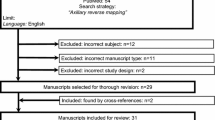Abstract
Background
The objective of axillary reverse mapping (ARM) is to preserve the main lymphatic chain—with both the nodes and the ducts—in relation to lymphatic arm drainage (LAD) during an axillary dissection (AD).
Methods
From July 2006 to March 2008, 23 patients with stage II or III breast carcinoma requiring an AD underwent an ARM procedure. Identification of the ARM nodes relied on an isotope injection into the web space of the ipsilateral hand. During AD, the radioactive ARM node was localized above the second intercostal brachial nerve, and blue dye was directly injected inside the node to visualize the efferent ducts, constituting the lymphatic ARM chain. The blue and radioactive nodes constituted the ARM sampling, while other nodes were considered part of the AD.
Results
Metastatic lymph node involvement was identified in the AD in 20 of 23 patients, with an average of 4.4 (1–11) nodes involved and an average of 10.7 (7–20) lymph nodes removed. The ARM sampling was performed in 21 of 23 patients (91%), with an average of 1.6 ARM nodes removed. In 18 of these 21 patients (86%), the nodes relating to ARM sampling had no metastatic involvement. There were 3 patients (14%) who demonstrated metastatic involvement of the ARM sampling, and all had pN3a (N+ > 9) involvement of the axilla.
Conclusion
This technique of combined isotopic and blue dye ARM and findings must now be validated. A multicentric study is planned to confirm this data.

Similar content being viewed by others
References
Hama Y, Koyama Y, Urano Y et al. Simultaneous two-color spectral fluorescence lymphangiography with near infrared quantum dots to map two lymphatic flows from the breast and the upper extremity. Breast Cancer Res Treat 2007; 103:23–8.
Nos C, Lesieur B, Clough K, et al. Blue dye injection in the arm in order to conserve the lymphatic drainage of the arm in breast cancer patients requiring an axillary dissection. A pilot study. Ann Surg Oncol 2007; 14:2490–6.
Thompson M, Korourian S, Henry-Tilman R et al. Axillary reverse mapping (ARM): a new concept to identify and enhance lymphatic preservation. Ann Surg Oncol 2007; 14:1890–5.
Ponzone R, Mininanni P, Cassina E, et al. Axillary reverse mapping in breast cancer: can we spare what we find? Ann Surg Oncol 2008; 15:390–1.
Klimberg VS. A new concept toward the prevention of lymphedema: axillary reverse mapping. J Surg Oncol 2007; 97:563–4.
Boneti C, Korourian S, Bland K et al. Axillary reverse mapping: mapping and preserving arm lymphatics may be important in preventing lymphedema during sentinel lymph node biopsy. J Am Coll Surg 2008; 206:1038–44. Epub 2008 Mar 3.
Sappey PC. (1874) Anatomie, Physiologie, Pathologie des vaisseaux lymphatiques. Paris: Adrien Delahaye.
Delamere G, Poirier P, Cuneo B. (1903) The lymphatics. In: Charpy PP, ed. A treatise of human anatomy. Westminster, UK: Archibald Constable and Co Ltd.
Rouvière H. (1932) Anatomie des lymphatiques de l’homme. Paris: Masson et Cie Edit.
Turner-Warwick RT. The lymphatics of the breast. Br J Surg 1959; 46:574–82
Sobotta J. (1977) Atlas d’Anatomie Humaine. Urban Schwarzenberg. München-Wien-Baltimore. Maloine S.A. Editeurs, Paris
Berg JW. The significance of axillary node levels in the study of breast carcinoma. Cancer 1955; 8:776–8.
Suami H, Taylor GI, Pan WR. The lymphatic territories of the upper limb: anatomical study and clinical implications. Plast Reconstr Surg 2007; 119:1813–22.
Pecking A, Clusan R. Exploration du système lymphatique: épreuve au bleu, lymphoscintigraphies directes, lymphoscintigraphies, autres méthodes. Encycl Med Chir (Elsevier, Paris), Angéologie 1997; 19 (1130):5
Weissleder H, Weissleder R. Lymphedema: evaluation of qualitative and quantitative lymphoscintigraphy in 238 patients. Radiology 1988; 167:729–35
Nos C, Lesieur B, Clough KB et al. Comments to the Letter to the Editor of Dr Ponzone. Ann Surg Oncol 2008; 15:392–3
Kjaergaard J, Blichert-Toft M, Andersen JA et al. Probability of false negative nodal staging in conjunction with partial axillary dissection in breast cancer. Br J Surg 1985; 72:365–7
Mathiesen O, Carl J, Bonderup O, Panduro J. Axillary sampling and the risk of erroneous staging of breast cancer. An analysis of 960 consecutive patients. Acta Oncol 1990; 29:721–5
Wilking N, Rutqvist LE, Carstensen J et al. Prognostic significance of axillary nodal status in primary breast cancer in relation to the number of resected nodes. Stockholm Breast Cancer Study Group. Acta Oncol 1992; 31:29–35
Singletary SE, Allred C, Ashley P et al. Revision of the American joint committee on cancer staging system for breast cancer. J Clin Oncol 2002; 20:3628–36
Montero AJ, Rouzier R, Lluch A et al. The natural history of breast carcinoma in patients with > or =10 metastatic axillary lymph nodes before and after the advent of adjuvant therapy: a multi-institutional retrospective study. Cancer 2005; 104:229–35
Cutuli B, Cottu PH, Guastalla JP et al. A French national survey on infiltrating breast cancer: analysis of clinico-pathological features and treatment modalities in 1159 patients. Breast Cancer Res Treat 2006; 95:55–64
Utada Y, Kasumi F, Yoshimoto M et al. The location of positive nodes partly influences the prognostic value of the number of positive nodes in breast cancer patients. Jpn J Clin Oncol 1999; 29:63–7
Acknowledgements
I thank particularly Miss Annabelle Roig for her contribution to the redaction of this article and Professor Genevieve Hidden for her extensive knowledge of lymphatic anatomy.
Author information
Authors and Affiliations
Corresponding author
Rights and permissions
About this article
Cite this article
Nos, C., Kaufmann, G., Clough, K.B. et al. Combined Axillary Reverse Mapping (ARM) Technique for Breast Cancer Patients Requiring Axillary Dissection. Ann Surg Oncol 15, 2550–2555 (2008). https://doi.org/10.1245/s10434-008-0030-z
Received:
Revised:
Accepted:
Published:
Issue Date:
DOI: https://doi.org/10.1245/s10434-008-0030-z




